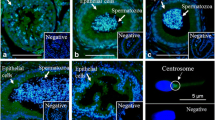Abstract
Purpose: Membrane cofactor protein (MCP), CD46, whose primary function is to protect host cells from homologous complement, has been presumed to serve as a sperm adhesion molecule for oocytes. The purpose of this study was to clarify the relationship between the properties of MCP expressed on epididymal sperm and their fertilizing ability in a recently developed strategy for assisted reproduction.
Methods: We collected ejaculated sperm from normal subjects and epididymal sperm from vasectomized subjects and patients with congenital absence of the vas deferens. Western blotting and cofactor activity assay were performed to investigated the structural and functional properties of MCP.
Results: Epididymal spermatozoa which showed a reduced fertilizing ability tended to react poorly with antibodies against MCP and also showed low cofactor activity, indicating weak complement regulatory activity compared to that of ejaculated spermatozoa.
Conclusions: MCP is sufficiently expressed in ejaculated sperm in men with a normally developed epididymis but is diminished in epididymal sperm from men with congenital or acquired obstruction of the vas deferens.
Similar content being viewed by others
References
Schlegel PN, Chang TSK: The testis, epididymis, and ductus defere. In PC, Walsh, AB, Retik, TA, Stamey, Vaughan, ED Jr (eds.), Campbell's Urology, Vol 1. Philadelphia: W. B. Saunders, 1992, p 202
Tournaye H, Devroey P, Liu J, Nagy Z, Lissens W, Van Steirtegh Microsurgical epididymal sperm aspiration and intracytoplasmic sperm injection: A new effective approach to infertility as a result of congenital absence of the vas deferens. Fertil Steril 1994;61:1045–1051
McIntyre JA, Faulk WP: Allotypic trophoblast-lymphocyte cross reactive (TLX) cell surface antigens. Hum Immunol 1982;4:27–35
Seya T, Turner J, Atkinson JP: Purification and characterization of a membrane cofactor protein (gp45–70) which is a cofactor for cleavage of C3b and C4b. J Exp Med 1986;163:837–855
Liszewski MK, Post TW, Atkinson JP: Membrane cofactor protein (MCP, CD46): Newest member of the regulators of complement activation gene cluster. Annu Rev Immunol 1991;9:431–455
Rooney IA, Oglesby TJ, Atkinson JP: Complement system in human reproduction: Activation and control. Immunol Res 1993;12:276–294
Vanderpuye OA, Labarrere CA, McIntyre JA: Review: The complement system in human reproduction. Am J Reprod Immunol 1992;27:145–155
Seya T, Hara T, Matsumoto M, Kiyohara H, Nakanishi, Kinouchi T, Okabe M, Shimizu A, Akedo H: Membrane cofactor protein (MCP: CD46) in seminal plasma and on spermatozoa in normal and “sterile” subjects. Eur J Immunol 1993;23:1322–1327
Kitamura M, Namiki M, Matsumiya K, Tanaka K, Matsumoto M, Hara T, Kiyohara H, Okabe M, Okuyama A, Seya T: Membrane cofactor protein (CD46) in seminal plasma is a prostasome-bound form with complement regulatory activity and measles virus neutralizing activity. Immunology 1995;84:626–632
Anderson DJ, Michelson MK, Johnson PM: Trophoblast-lymphocyte common antigen is also expressed on human testicular germ cells and appears on the surface of acrosome-reacted sperm. Biol Reprod 1989;41:285–293
Simpson KL, Holmes CH: Presence of the complement-regulatory protein membrane cofactor protein (MCP, CD46) as a membrane-associated product in seminal plasma. J Reprod Fertil 1994;102:419–424
Cervoni F, Oglesby TJ, Adams EM, Milesi-Fluet C, Nickells M, Fenichel P, Anderson JP, Hsi BL: Identification and characterization of membrane cofactor protein of human spermatozoa. J Immunol 1992;148:1431–1437
Okabe M, Ying X, Nagira M, Ikawa M, Kohama Y, Mimura T, Tanaka K: Homology of an acrosome-reacted sperm-specific antigen to CD46. J Pharmacobio-Dyn 1992;15:455–459
Fenichel P, Dohr G, Grivaux C, Cervoni F, Donzeau M, Hsi BL: Localization and characterization of the acrosomal antigen recognized by GB24 on human spermatozoa. Mol Reprod Dev 1990;27:173–178
Sundstrom SA, Komm BS, Ponce-de-Leon H, Yi Z, Teuscher C, Lyttle CR: Estrogen regulation of tissue specific expression of complement C3. J Biol Chem 1989;264:16941–16947
Anderson DJ, Abbott AF, Jack RM: The role of complement component C3b and its receptors in sperm-oocyte interaction. Proc Natl Acad Sci USA 1993;90:10051–10055
Ohashi K, Tsutsui T, Saji F, Tomiyama T, Kato M, Tanizawa O: Acrobeads test: A new diagnostic test for assessment of the fertilizing capacity of human spermatozoa. Fertil Steril 1995;63:625–630
Taylor CT, Biljan MM, Kingsland CR, Johnson PM: Inhibition of human spermatozoon-oocyte interaction in vitro by monoclonal antibodies to CD46 (membrane cofactor protein). Hum Reprod 1994;9:907–911
Eddy EM, Vernon RB, Muller CH, Hahnel AC, Fenderson BA: Immunodissection of sperm surface modification during epididymal maturation. Am J Anat 1985;174:225–237
Seya T, Hara T, Matsumoto M, Akedo H: Quantitative analysis of membrane cofactor protein (MCP) of complement: High expression of MCP on human leukemia cell lines, which is down regulated during cell differentiation. J Immunol 1990;145:238–245
Matsumoto M, Seya T, Nagasawa S: Polymorphysm and proteolytic fragments of granulocyte membrane cofactor protein (MCP; CD46) of complement. Biochem J 1992;281:493–499
Miller DJ, Macek MB, Shur BD: Complementarity between sperm surface beta-1,4-galactosyl transferase and egg-coat ZP3 mediates sperm-egg binding. Nature 1992;357:589–593
Tulsiani, DRP, Skudlarek MD, Holland MD, Orgebin-Crist MC: Glycosylation of rat sperm plasma membrane during epididymal maturation. Biol Reprod 1993;48:417–428
Simpson KL, Holmes CH: Differential expression of complement regulatory proteins decay-accelerating factor (CD55), membrane cofactor protein (CD46) and CD59 during human spermatogenesis. Immunology 1994;81:452–461
Author information
Authors and Affiliations
Rights and permissions
About this article
Cite this article
Kitamura, M., Matsumiya, K., Namiki, M. et al. The fertilizing ability of human epididymal sperm. J Assist Reprod Genet 13, 652–656 (1996). https://doi.org/10.1007/BF02069644
Received:
Accepted:
Issue Date:
DOI: https://doi.org/10.1007/BF02069644




